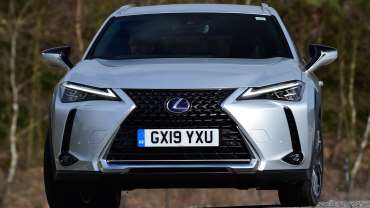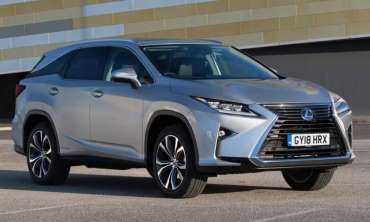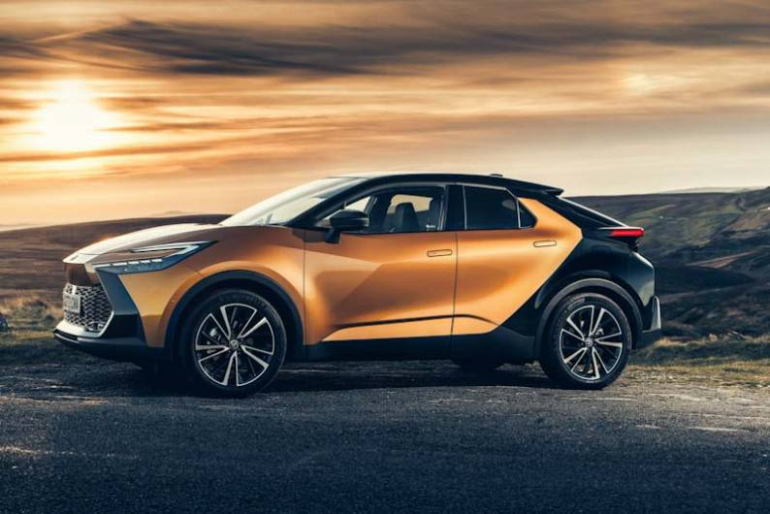Displaying items by tag: lexus
VIDEO: Test 2021 Lexus IS 300
For 2021 Lexus has updated the looks, tech and performance of the popular IS 300 Sedan. Can Lexus fend off the competition in this segment? We have a complete look.
2021 Lexus IS 350 Review: Refocused but Not Rejuvenated
The verdict
A few mild updates keep Lexus’ sporty IS sedan alive and kicking, aimed squarely to capture the few remaining sports sedan buyers left on the market.
Versus the competition
The updates don’t go deep enough to make the IS 350 fully competitive against newer, fresher, faster rivals like the BMW M340i, Genesis G70 or Acura’s new TLX.
The beautiful thing about so many people starting to abandon entry-level luxury sedans for entry-level luxury SUVs and crossovers is that for the few remaining players in this class, a change is taking place. This is becoming especially obvious at the Japanese luxury brands, where instead of abandoning compact sports sedans, they’re changing their focus. No longer are they just entry-level models; the latest ones are being realigned specifically to be appealing sports sedans. The thinking goes that anyone still looking at a sedan over an SUV is really in it for the style and fun-to-drive factors, so why not make them the main focus of the car?
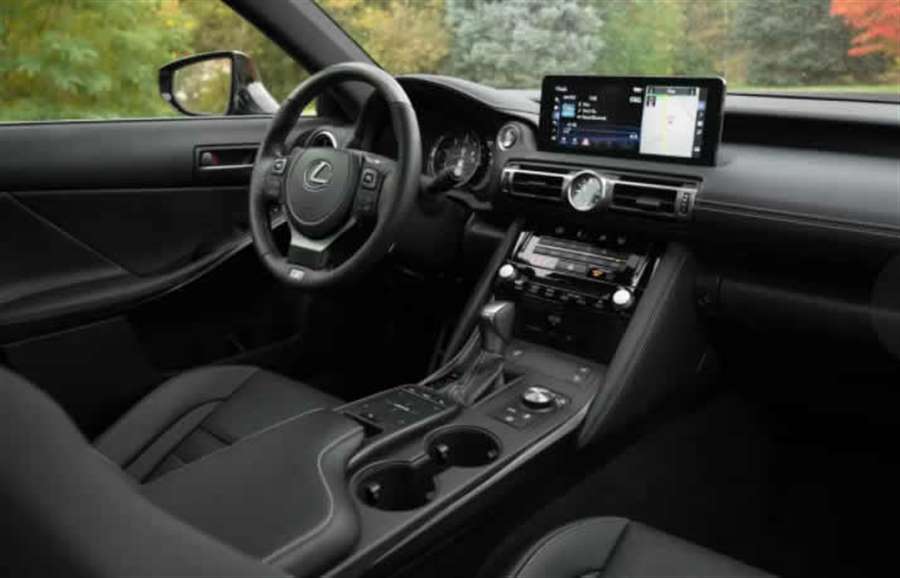
Acura did it with the new 2021 TLX, and now Lexus has done it with the 2021 IS 300 and IS 350. But has the redo and realignment of the IS gone far enough to keep it competitive against newer, fresher, faster rivals?
Looks a Bit Fresher
There are two models to choose from in the new IS lineup: the entry-level IS 300 with a 241-horsepower, turbocharged 2.0-liter four-cylinder engine, or the IS 350 you see here with its naturally aspirated 311-hp, 3.5-liter V-6. Either model can be had with rear- or all-wheel drive, but if you go for an IS 300 AWD, it actually comes with a less powerful, 260-hp version of the V-6 that also has less torque than the turbo four-cylinder. All RWD cars come with a standard eight-speed automatic transmission, while AWD cars come with a six-speed automatic.
Here’s where we start to see the new focus on making the IS a sporty sedan: The IS 300 F Sport is no longer a thing. You can’t get the F Sport handling and appearance package on that version — but all IS 350 models automatically come with the F Sport trim, meaning you can get an IS 350 only in F Sport guise. If you opt for the IS 350 (which you probably should given its significant power advantage over the IS 300), you’ll be getting this — a compact sports sedan with a 311-hp nonturbo V-6 carried over from the past model year with standard rear-wheel drive, an eight-speed automatic, a sport suspension, standard 19-inch wheels and more aggressive styling.
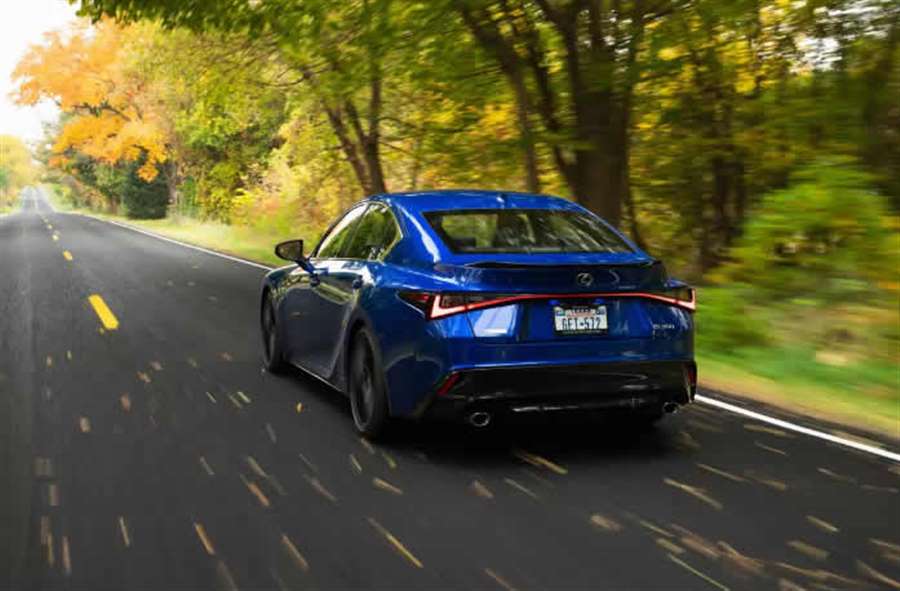
Lexus has updated the look of the IS for 2021, and I have to say that it’s a subtle but definite improvement. Those weird Nike swoosh signature LED lights up front have now been well integrated into the larger headlight assembly and look much, much better. The Lexus signature spindle grille is still here, but it’s either simply grown on us or just doesn’t look as offensive as it used to; either way, I think we’re finally used to it. The fenders are a tad wider to accommodate the bigger wheels and tires on the IS 350 F Sport, and a new trunk and rear bumper with a full-width LED taillight makes for more muscular-looking haunches. The Dynamic Handling Package available on the F Sport brings a couple of styling changes, too, including the addition of lovely matte-black 19-inch BBS wheels and a rather unnecessary carbon-fiber trunk spoiler. The overall changes have cleaned up the IS 350 considerably, giving it a lower, wider, more menacing appearance that’s less funky but more attractive.
Doesn’t Drive Any Differently
Out on the street, the new IS 350 really doesn’t feel that different from the last one. More than 300 horsepower might sound like a lot on paper, but 280 pounds-feet of torque isn’t all that impressive anymore, and it shows up in the IS 350’s rather underwhelming straight-line acceleration. Many of its competitors, such as the Acura TLX, Alfa Romeo Giulia, Genesis G70 and BMW 330, all employ turbocharged engines with torque that’s available low in the rev range, making for punchier acceleration than the IS 350 delivers. The IS certainly isn’t slow, but neither does it have the immediacy you’d expect when you floor the accelerator as you enter a highway on-ramp or pull out in front of traffic. Lexus’ given 0-60-mph time of 5.6 seconds isn’t exactly class-leading anymore. The eight-speed automatic transmission is well executed and does a decent job of providing smooth shifts, but it doesn’t seem quick or eager to kick down when you plant your foot, only adding to the more relaxed, slightly underpowered feeling the IS 350 delivers. Simply put, the IS 350 feels like it could use a more up-to-date engine and transmission combo, something that would boost its acceleration to match the more powerful and similarly priced offerings like the BMW M340i or Infiniti Q50 Red Sport 400.
There’s not much to fault with the IS 350’s handling, however. The suspension provides an excellent balance of comfort and responsiveness that really does impress with its sophisticated feel. For a bit more money, you can specify the Dynamic Handling Package for your IS 350 F Sport that includes an electronic adaptive suspension, adjusting the ride firmness and response via a mode selector on the center console. I honestly didn’t find that it affected the ride quality or steering effort noticeably if I switched from Normal mode to Sport S or Sport S Plus modes, but it did seem to wake up the powertrain with a more responsive throttle and allow more revs to build before shifting. Keeping it in Sport modes isn’t really conducive to serene driving, however, so you’re likely going to just keep it in Normal where the IS 350 proves to be a pleasantly quiet touring car that allows for faster cruising speeds than you might otherwise expect.
Time to Rethink the Interior
Inside, there have been a few changes to the IS 350 for 2021, but again the car is showing how much it could use a rethink to its whole platform. The interior mixes decent fake leather and nice ash wood accents on the F Sport with unremarkable plastic surfaces. One notable option is the Circuit Red interior, which truly looks stunning — sadly, my test car came outfitted with a more somber, less interesting black interior. You have a highly welcome new touchscreen front and center, which finally allows you to skip using Lexus’ remote control for the multimedia system. An 8-inch screen (measured diagonally) is standard, and the 10.3-inch screen in my test car is optional on vehicles equipped with navigation. It’s almost 6 inches closer to the driver than the previous screen, so it’s easier to see and reach. Apple CarPlay and Android Auto are standard, as is Amazon Alexa integration.
Lexus’ maddening remote joystick control has been replaced by a new touchpad, which is a bit better, but there’s no substitute for being able to touch the screen directly to do what you want to do. Thankfully, Lexus has finally realized that.
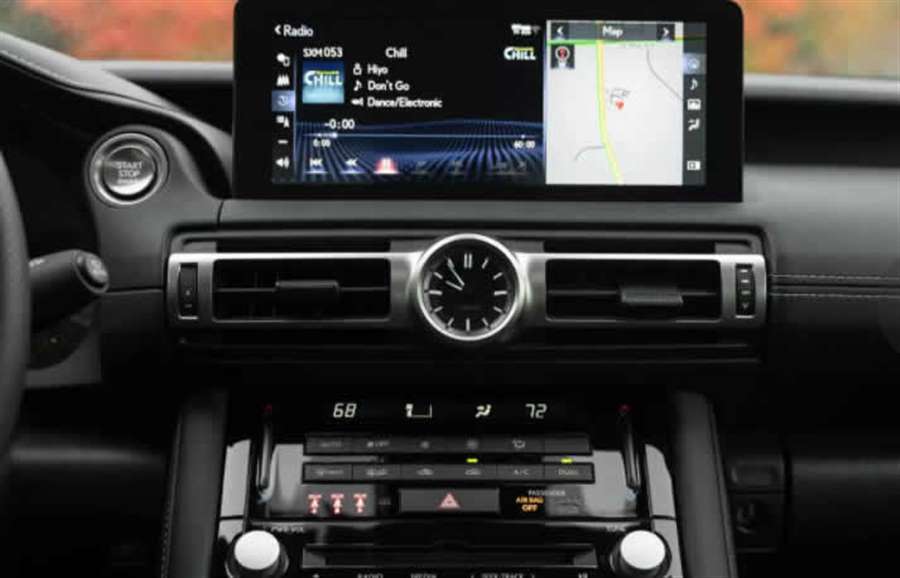
There isn’t much continuity to button design, with some buttons feeling large and well labeled, while others are tiny and hard to find, and still others are almost completely obscured from the driver’s view and difficult to use at all. The digital gauge cluster features an unusual sliding round master gauge that first appeared in F Sport versions of the IS and other Lexuses many years ago, inspired by the LFA supercar, but it honestly just seems needlessly gimmicky. And the fact that a bright green “Eco” light illuminates in the gauge cluster whenever the engine enters its fuel-saving mode is really annoying. In short, the IS 350’s interior layout and control strategy needs a modern redo.
But that’s not really the biggest issue with the interior. The IS 350 is cramped inside, with a narrow cabin and fairly tight seats. It features an unusually high driving position that feels as if the seat could stand to be an inch or two lower; more adjustability to the bottom cushion’s angle would be nice, too. The rear seats are also tight, with adequate room for two on short trips and decidedly more legroom than, say, an Alfa Romeo Giulia, but overall room in back feels about average for this category of sedan. There’s plenty of room in the trunk, and the rear seats do fold to allow for larger items. Yes, this is a compact sports sedan, and nobody’s expecting it to be a limousine. But its overall design aesthetic, packaging and control layout all seem to be in need of a more comprehensive update.
A Better Value Only on Base Models
The basic Lexus IS 300 RWD starts at $40,025 (all prices include destination), and my IS 350 F Sport RWD test car starts at a still reasonable $43,925, which rings in several thousand dollars less than the 2020 IS 350 F Sport thanks to Lexus’ new trim strategy. Add the moonroof, Dynamic Handling Package, navigation with premium Mark Levinson audio and a few other odds and ends, and you come to my car’s as-tested price of $55,220. That’s a little harder to swallow, frankly, given the other competitors you have at this price like a BMW M340i or Infiniti Q50 Red Sport 400, both of which outgun the IS 350 in the powertrain department. Or even opt for the new 2021 Cadillac CT5-V or Genesis G70 3.3T, both of which also feature more powerful engines for less money, accompanied by more modern interiors.
Lexus’ entry-level sports sedan is meant to be a good starting point for fans looking to get into the brand, and its refocused energy on capturing the few remaining sports sedan buyers with a more value-oriented F Sport model is commendable. But its updates for 2021 didn’t quite go far enough to make it a more competitive offering versus the considerably newer, fresher and more powerful competitors. Still, it has its looks and refinement going for it, along with Lexus’ reputation for reliability. If those factors weigh more heavily for you, then the new 2021 Lexus IS might be worth putting on your shopping list.
Cars.com’s Editorial department is your source for automotive news and reviews. In line with Cars.com’s long-standing ethics policy, editors and reviewers don’t accept gifts or free trips from automakers. The Editorial department is independent of Cars.com’s advertising, sales and sponsored content departments.
Source: cars.com
Tested: 2021 Lexus IS350 F Sport Deserves a Better Engine
Lexus's updated IS350 F Sport has the looks to kill but it doesn't deliver sufficient thrills.
Sedans are dead, at least that's the conventional wisdom. The trend toward crossovers has seemingly placed four-door cars on death row, but while they're down, they're not out of appeals. New sports sedans are still being introduced. Lexus's updated 2021 IS350 F Sport is just such a sedan, but is it good enough to find enough buyers to save itself from the gallows?
First introduced for the 2014 model year, the third-generation Lexus IS has been reformed by a second mid-cycle refresh in an attempt to keep up with newer offerings like the BMW 3-series, Cadillac CT4-V, Genesis G70, and the still lovely Mercedes-Benz C-class. Designers went to work on the sheetmetal with a smoothed-out profile, squinty headlights, and following the trend, an even larger grille. It's a killer-looking sedan, especially when dressed in the IS350's standard F Sport garb and blacked-out trim.
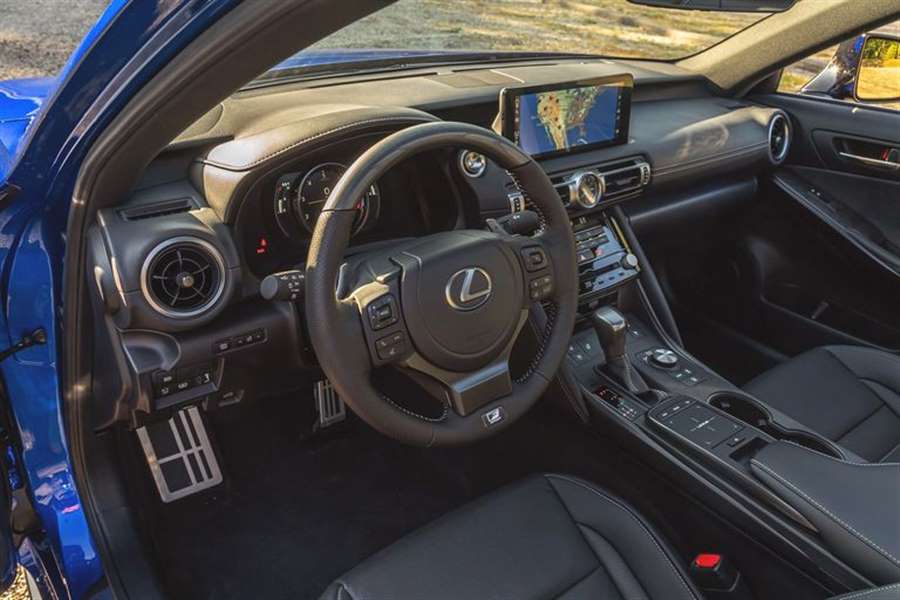
HIGHS: Stunning curb appeal, tasteful interior, comfortable seats.
While the IS's looks will please your optic nerve, the segment is one that emphasizes performance. Beneath the hood of the rear-wheel-drive IS350 F Sport is Lexus's familiar 3.5-liter V-6 producing a naturally aspirated 311 horsepower and 280 pound-feet of torque. Against turbocharged fours and sixes, the V-6 seems a step behind the times. The engine lacks the low-rpm shove that comes from most turbocharged mills, and the eight-speed automatic delivers lackadaisical shifts. Acceleration to 60 mph takes 5.6 seconds, and the quarter-mile is gone in 14.2 seconds at 100 mph. While those numbers would have been good a decade ago, today the IS350 F Sport finds itself competitive with the base turbocharged inline-fours offered in its class. For a sedan with such seductive looks, it deserves an updated V-6 with more power.
In an effort to improve handling, Lexus has also retuned the chassis. There are additional welds in the unibody to strengthen the structure, aluminum control arms replace steel ones, springs and anti-roll bars have been lightened, and a switch to lug bolts instead of nuts saves two pounds. Our test car arrived with the $4200 Dynamic Handling package that includes lightweight 19-inch BBS wheels that shave a claimed 16 pounds, adaptive dampers, and a Torsen limited-slip rear differential.
LOWS: A naturally aspirated V-6 in a world gone turbo, chassis shows promise but is held back by an overly vigilant stability control system.
All of the changes sound great on paper, but on the street there's still some structural flimsiness and the steering isn't as precise as the CT4-V's or the G70's. Lexus fits Bridgestone Potenza S001L summer rubber that seems tuned more for comfort than all-out grip. There's also the matter of a stability-control system that reactivates itself above 30 mph. This car's 0.89 g of stick on the skidpad is far from noteworthy. A Camry TRD outgrips the IS350 on the skidpad. Standing on the left pedal at 70 mph stops the IS350 in a competitive 155 feet, but the force of the stop seemed to trigger a low-oil pressure alert. This isn't something we've experienced with this engine before, so it may be a pre-production bug.
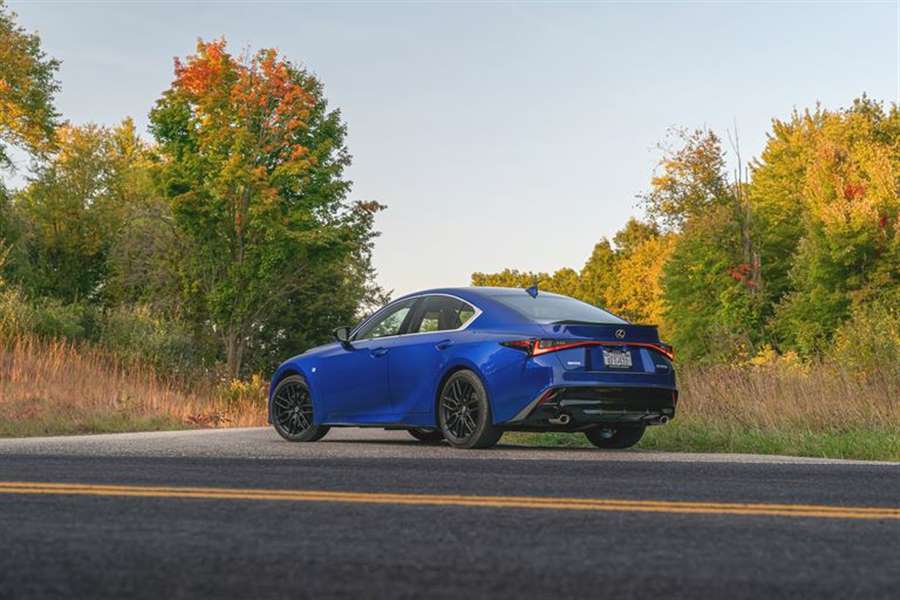
We found few problems with the tastefully appointed cabin. Supple leather and wood trim dress up the revised dashboard. The seating position and comfort of the bucket seats is spot on, but our enthusiasm wanes when we start using the infotainment system's touchpad. Though Lexus remains dedicated to fitting the haptic pad to operate the infotainment system, it's easily avoided by using the standard 8.0-inch or optional 10.3-inch touchscreen. Mounted nearly six inches closer than before, they're an easy tap away. Technophiles will find solace now that Amazon Alexa, Android Auto, and Apple CarPlay compatibility are standard.
The good news for IS350 buyers, is that its $43,925 starting price is $2475 less than last year's IS350 F Sport. A looker inside and out, the low-stress V-6 could definitely use more muscle and the handling could be more engaging and fun. Add in our car's as-tested $55,200 price, and we were in a less forgiving mood. A new engine would go a long way toward helping the IS sedan stay off death row.
Source: caranddriver.com
Lexus UX SUV review
"The economical Lexus UX looks and feels great, but falls short on versatility"
The premium compact SUV class is growing rapidly at the moment. Buyers can't get enough of fashionable crossovers such as the BMW X2 and Audi Q2. 'Hybrid' has become something of a buzzword, too, so a hybrid premium compact SUV really ought to be a sales sensation.
This is what Lexus, the upmarket arm of Toyota, hopes for its all-new UX 250h. It's the smallest SUV the company has yet offered, slotting beneath the Lexus NX in the brand's line-up and offering an alternative to its other hybrid model, the more conventionally styled Lexus CT hatchback. It'll also compete against the Jaguar E-Pace and Volvo XC40, while potentially persuading would-be Toyota C-HR buyers to push a little further upmarket.
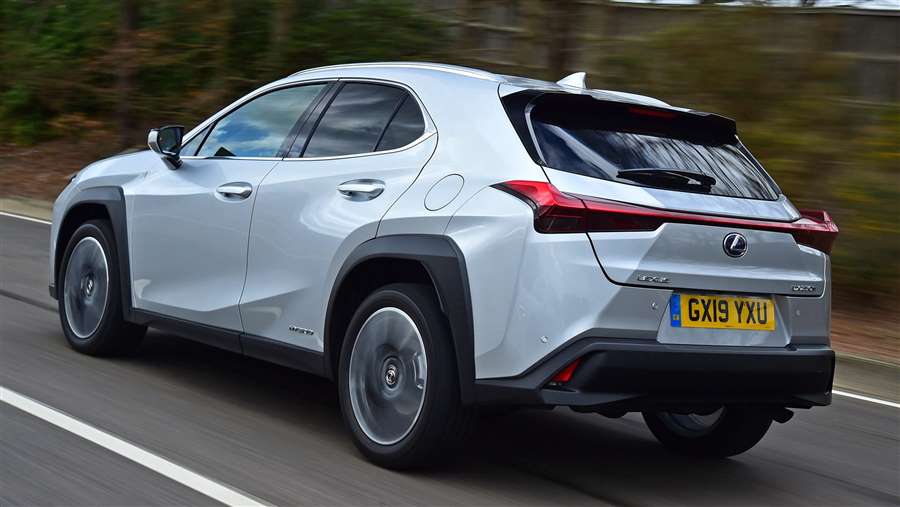
It comes as no surprise that Lexus should opt for hybrid power in its smallest SUV – the larger Lexus RX was something of a pioneer, offering hybrid power since 2004. The technology has since made big leaps forward in fuel-efficiency, though, and Lexus claims some fairly startling economy figures for the smaller, lighter UX. Modest CO2 emissions figures should make the UX an attractive proposition for company-car users, too.
Externally, the Lexus UX wears the brand's trademark 'spindle' grille, but isn't quite as bold and outspoken as the larger Lexus NX. The overall shape has the sleek silhouette of the latest coupe-SUVs, and despite its tough-looking black wheelarch mouldings, the stance is more soft-roader than go-anywhere vehicle.
That streamlined shape is reflected inside, where interior headroom is more saloon than SUV and the driving position is only a little higher than a typical family hatchback. Boot space is rather meagre, too, so this might be a crossover more suitable for couples than larger parties.
Although some may miss the lofty perch that other SUVs can provide, many will enjoy the UX's sporty driving position; there's no doubt it contributes to the driving experience, which feels a little more involving than some rivals. It just goes to show how capable Toyota's TNGA platform – also found under the Toyota Prius hybrid and latest Toyota Corolla – really is. Four-wheel drive is also offered in the UX 250h hybrid, badged E-Four, but we wouldn't recommend this version unless you really need extra traction in winter, because it makes the car less efficient.
Touted as a cutting-edge product at launch, the UX ticks all the usual safety boxes with autonomous emergency braking, lane-departure warning, traffic-sign recognition and automatic headlights. There's a radar cruise-control system, too, with a mode for use in stop-start traffic at up to 18mph.
Lexus proudly occupies the number-one slot in our 2020 Driver Power owner satisfaction survey, even though the brand's three-year/60,000-mile warranty is less generous than Toyota's.
If you'd rather a longer warranty, the Toyota C-HR hybrid remains a less expensive – and slightly more spacious – alternative to the Lexus UX, but many will find the latter's extra style and interior appeal worth the extra outlay. High-mileage private buyers may find conventional diesel-powered rivals, such as the BMW X1 sDrive18d, will be cheaper to run, too.
Lexus UX MPG & CO2
The Lexus UX 250h uses the very latest hybrid technology that Toyota has to offer, having much in common with the latest Toyota Prius. Official WLTP figures span from 50.4 to 53.2mpg for the standard UX and 47mpg for the four-wheel drive version. We managed 50mpg in a test car, despite the big 18-inch alloy wheels included with the F-Sport trim level.
Stick with two-wheel drive and the Lexus UX emits from 120g/km of CO2 with 17-inch wheels fitted and 126g/km with 18-inch alloys. Benefit-in-Kind (BiK) liability for company-car drivers spans from 27 to 28%. Emitting around 135g/km, the four-wheel drive UX sits in a higher BiK band with either size wheels.
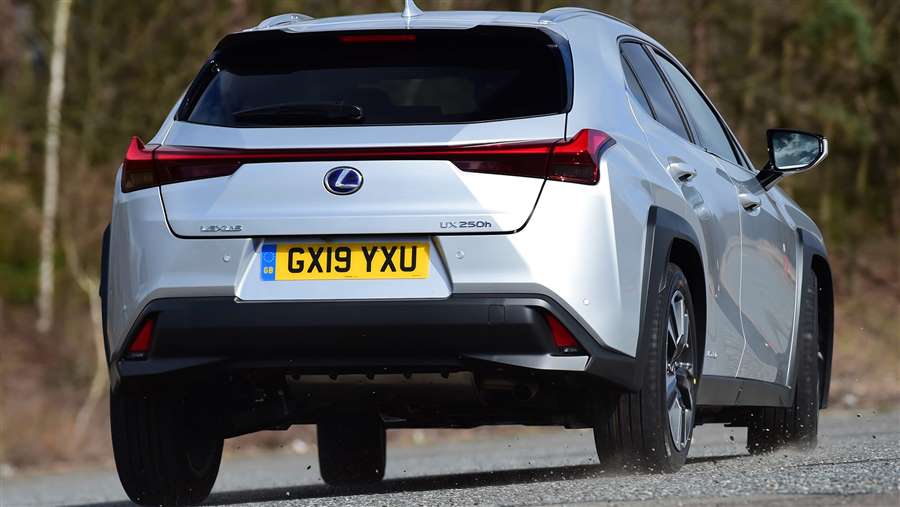
Insurance
The Association of British Insurers has placed the Lexus UX in insurance groups 22 to 26 out of 50, making the Lexus a little more expensive to insure than the cheaper but mechanically related Toyota C-HR hybrid, which occupies insurance group 14 in top-spec Excel form. Meanwhile, the most economical Mercedes GLA is in insurance group 21, while the BMW X1 starts in insurance group 26.
Servicing
Lexus offers fixed-price servicing for all models. Although pricing for the UX has yet to be announced, service schedules are sure to match the pattern of other hybrid models in the range, with a major service every 20,000 miles and an intermediate oil-change service every 10,000 miles.
Warranty
Lexus' three-year/60,000 mile warranty closely matches that provided by Volkswagen and Audi, but falls behind the three-year/unlimited-mileage warranties of Mercedes and BMW. It also lags behind that provided by Toyota, which lasts for five years or 100,000 miles. Lexus can provide an extended warranty, though, keeping you covered once your original policy's age or mileage limit is breached. It's also worth noting that the hybrid powertrain comes with a five-year/60,000 mile warranty for extra peace of mind.
The Lexus UX 250h uses a platform known as Toyota New Generation Architecture (TNGA), which underpins a range of cars as diverse as the Toyota Prius, Toyota Corolla and Toyota C-HR. That fact might not scream 'sporty', but prospective Lexus UX purchasers are in for a pleasant surprise.
Sitting in a driving position somewhat lower than that of most compact SUVs, you're well placed to get the most out of how the Lexus handles. That's no empty gesture, either, because the UX really does offer enough driving involvement to be a pleasure to drive. The steering is accurate and has a pleasingly weighty feel, while strong grip helps confidence in sharp corners.
Lexus claims to have gone to some lengths to make the UX feel good to drive, taking the trouble to mount the steering rack directly to the chassis in an effort to reduce flex and vibration, and these efforts have definitely paid off; the UX is more fun to drive than the Audi Q2 and runs the BMW X2 close. What's more, the car's impressive resistance to lean in corners doesn't come at the expense of a hard ride, at least not with the optional adaptive damping system fitted. We've yet to evaluate how the standard suspension deals with road imperfections.
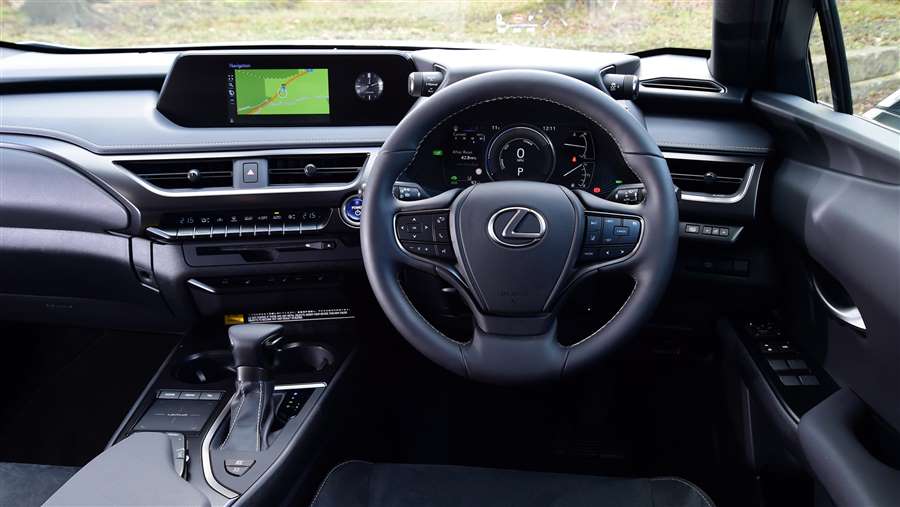
The UX is available with either front-wheel drive or 'E-Four' all-wheel drive, but the latter is intended more to maximise traction on poor roads and in adverse weather conditions than to bestow the UX with real all-terrain ability. For most buyers, we'd recommend saving the £1,200 or putting it towards a set of winter tyres for the front-wheel drive version.
Lexus UX hybrid engine
Only one engine is offered for the Lexus UX – the 250h. It's billed as a 'self-charging' hybrid, but that tag is little more than a positive spin on the fact that it has no plug-in facility. As a result, the UX can only move under all-electric power at moderate speeds, but it does bring a welcome degree of quietness in urban traffic.
The four-cylinder 2.0-litre petrol engine produces 144bhp and twin electric motors contribute 108bhp, making 0-62mph possible in 8.5 seconds. It feels quicker off the mark than the Audi Q2 fitted with a 1.5-litre turbo and driving is effortless thanks to a CVT automatic gearbox that proves smooth and seamless in operation. Unusually, the paddles either side of the steering wheel aren't for changing gear, but for setting the rate of regenerative braking. This system uses energy released during deceleration to help charge the UX's hybrid battery.
The E-Four four-wheel drive version gets an extra motor for the rear wheels, providing up to 7bhp and 55Nm of pulling power but also adding 60kg of weight. In most driving situations it feels identical to the front-wheel drive version, with enough electric assistance to prevent the petrol engine from feeling overworked. However, with less weight, the standard UX can run in EV mode more often, so unless you park on a slippery field or track every day, the benefits are marginal.
Interior & comfort
The Lexus UX looks and feels great inside
The Lexus UX is generally smooth and relaxing to travel in. At higher cruising speeds, its slippery shape helps to keep wind noise at bay, and occupants will find tyre noise far more intrusive than any other mechanical sound. The clever (optional) active damping system is effective at ironing out road bumps, but we've yet to try the standard suspension.
Lexus has established an enviable reputation for interior design and quality, and the UX doesn't disappoint. The materials used are from the top drawer, and the layout is distinctive and pleasing to look at. Enthusiasts might even spot a few visual influences from the range-topping Lexus LC sports coupe.
Lexus UX dashboard
The UX's dashboard sweeps around the driver, who's placed right in the centre of the action. The instrument cluster is a little smaller than that of some rivals, but its seven-inch digital display is clear and easy to understand and can be configured to your taste.
Lexus UX interior19
Major features, such as the climate-control system, are easy to use thanks to piano-style buttons in the centre console. However, we remain unconvinced by the touchpad system that Lexus employs for its infotainment systems. It's fiddly to use when at a standstill, and worse when you're on the move. There's no Apple CarPlay or Android Auto on board, either, but the wide central touchscreen looks great.
Equipment
The UX is available in three trim levels. The entry-level model is simply the UX, followed by F Sport and top-spec Takumi.
The UX comes with sat nav, dual-zone air-conditioning and 17-inch alloy wheels, along with compatibility with Android Auto and Apple CarPlay. The F Sport has sporty styling extras to give it a more muscular appearance, as well as 18-inch alloy wheels, sports seats, pedals and steering wheel. The trim level also includes heating for the seats and steering wheel, plus tinted rear windows. There's also the option of Active Sound Control (ASC), which "generates the aural effect of up and downshifts like those of a geared automatic transmission". In common with other cars that offer a digitally synthesised engine noise to increase aural stimulation, the F-Sport is available with Sonic Interaction Design (SID). It allows you to tailor the 'engine sound' when Sport S+ mode is engaged.
The Takumi version of the UX features leather upholstery, ventilated seats, a Mark Levinson 13-speaker sound system, a 10-inch multimedia display, 360-degree camera, driver’s head-up display, sunroof, blind spot monitor and rear cross traffic alert.
Options
Five option packs are available for the UX. The Premium Pack (available for UX and F Sport trims) includes 18-inch alloy wheels, front and rear parking sensors, rear privacy glass, integrated heating in the front seats and steering wheel and an auto-dimming rear-view mirror.
Taking luxury specification to an even higher level, the Premium Plus Pack adds leather upholstery, smart entry, a powered tailgate and illuminated entry system. F Sport buyers also get a 10-inch multimedia display and power-adjustable steering wheel as part of the pack.
Introduced for 2020, there's also a Premium Pro Pack. This includes the kit in the Premium Plus Pack and adds blind-spot monitoring, rear cross traffic alerts, a head-up display, adaptive LED headlights, a 13-speaker Mark Levinson stereo, wireless smartphone charging and power adjustable seats.
The Tech & Safety Pack equips the car with a blind spot monitor, rear cross traffic with auto brake, triple-eye LED headlights, a driver’s head-up display and a wireless charging tray for smartphones. The F Sport model also gets adaptive suspension as part of this pack, which provides automatic, independent, damping force at each wheel in response to driver inputs and road conditions.
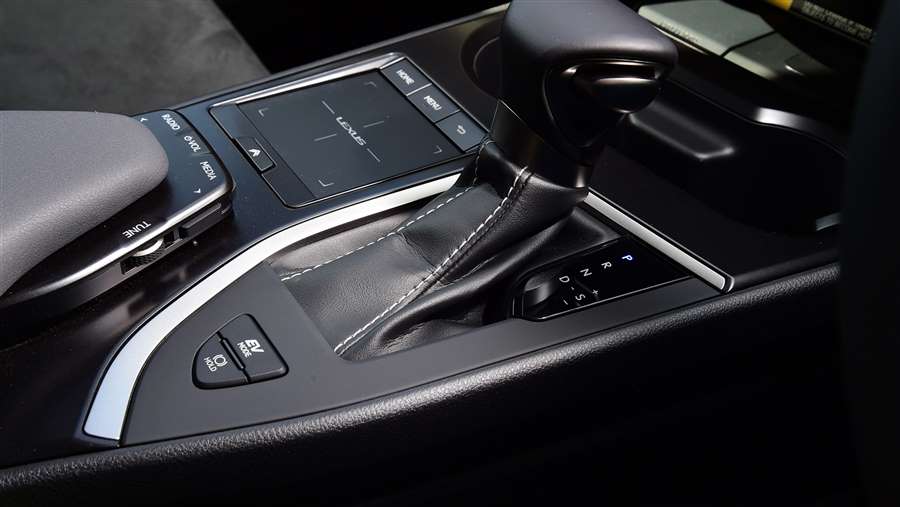
The UX model is available with a Tech & Sound Pack that equips the vehicle with the Mark Levinson audio system, head-up display, wireless charger and power-adjustable front seats and steering wheel.
The F Sport model is available with a Takumi Pack, which includes everything in the Premium Plus and Tech & Safety Packs, together with front seat ventilation, the Mark Levinson audio system, a sunroof and 360-degree camera. If you want to inject some extra flair, there's also a new ‘Cobalt’ blue trim colour for 2020, as well as an ‘F White’ colour scheme with contrasting black and white leather for the seats and dashboard.
Practicality & boot space
The Lexus UX is reasonably spacious for passengers, but boot space is tight
The restrictions enforced by the Lexus UX's compact overall dimensions presented its designers with a major challenge when it came to interior packaging, and the sleek crossover is further hamstrung by its low, curvaceous roofline. As a result, although space inside is adequate, there's no mistaking the Lexus UX for a versatile family car.
Lexus UX interior space & storage
Front-seat passengers get by far the best deal inside the UX, where the wraparound dashboard gives the driver a cocooned feeling without claustrophobia setting in. There's more headroom than you might expect, thanks largely to the low-set seats.
The same is true in the back, but the narrow windows don't let a great deal of light in. It means rear-seat passengers get the impression of there being less space than there actually is, and most will actually find knee and headroom adequate.
Boot space
With a high floor, boot space is just 320 litres - a small size for the class and 150 litres less than the BMW X2 offers. Things get even worse with four-wheel drive fitted, because the extra mechanical hardware reduces boot space to 283 litres - less than you get in a Ford Fiesta.
The rear seats fold with a 60:40 split should you need to expand the boot without passengers on board, but the steeply raked rear windscreen puts paid to the notion of carrying bulky items.
Source: carbayer.com
Lexus RX L review
Seven-seater version of beautifully built Lexus hybrid SUV
The Lexus RX L is a seven-seated version of the Lexus RX, a large SUV that's been offering buyers the choice of hybrid capability for 20 years.
Hybrid SUVs scything through big cities might be commonplace now, but it wasn't the case in the late nineties. Then Lexus came along with the original RX, changing the way posh city dwellers drive. Now people could choose a large car with an imposing seating position that was also kind to the environment.
The RX is equally as good away from tight city streets, and now it has another string to its bow - seven seats, in the form of this RX L.
The RXL goes toe-to-toe with the likes of the Audi Q7, Volvo XC90, BMW X5 and Range Rover Sport. It's pitched as a standalone model that sits alongside the five-door RX. Lexus reckons two thirds of customers will choose five seats, while one third will opt for seven.
Lexus RX 450hL: the seven-seater SUV
Only one variant is sold in the UK: the RX 450h L. The h in that name signifies that it’s the hybrid petrol-electric version. Other markets elsewhere in Europe offer a petrol-only powertrain, but it’s not available here.
The 3.5-litre V6 petrol engine is mated to an electric motor on each axle and the RX L constantly juggles between the power sources; there is an EV Mode button on the centre console that drivers can select if they want to whirr around town silently for ultimate eco-warrior status. Just be mindful that you can only drive for a couple of miles before the small battery will be depleted and the engine kicks in to take over.
Do I have to plug in my Lexus RX L?
No - it is not a plug-in hybrid electric vehicle, or PHEV. Instead, the V6 petrol provides charge to the nickel metal hydride battery pack under the rear seats and this is why Lexus has started referring to the technology as a self-charging hybrid.
The system works well and there is little complication for drivers to tackle; merely slot the automatic transmission into D for Drive and set off. Electronics constantly shuffle the power supply, the only indication of what’s happening being the electronic display between the speedo and power supply dial.
Lexus RX 450hL prices and specs
With only a single engine available, the RX L price structure is very simple. UK prices start from just under £53,000, around £1,300 more expensive than the regular five-seat RX.
Choose from two trim levels: RX 450hL and Takumi.
RX 450hL 20-inch alloys, keyless entry, 12.3-inch infotainment with Apple CarPlay and Android Auto, electric tailgate
Takumi (in addition to standard car) Heated/ventilated front seats, 360-degree camera, Mark Levinson Surround Sound System
Lexus RX L review: what's it like to drive?
It’s important to realise that the RX 450hL shares the same wheelbase as the regular RX - the underlying oily bits are the same and there is no change to the distance between the wheels. Instead, the extra space comes from an elongated rear end, stretched by 110mm.
So, it drives in a very similar fashion to the five-seat car. The Lexus RX L is now a long vehicle at precisely five metres and heavy at around 2.2 tonnes, but it never feels unwieldy. Although the parking sensors and cameras are really appreciated when squeezing into tight spaces.
On the road, the RX 450hL has a laid-back gait: this is an extremely relaxing car to drive, with impeccable refinement, whisper-quiet powertrain and little wind noise (double glazing helps here). At a cruise, it is extremely impressive.
However, that peace is disturbed somewhat if you go for an overtake or drive up a steep hill; the Continuously Variable Transmission (CVT) gearbox sends the revs soaring sky-high as the V6 engine wakes up and provides its thrust. In fairness, the powertrain is much better than earlier iterations and in day-to-day driving, it’s much more relaxed.
It is impressive how frequently the car runs on electric power alone; a green EV logo lights up in the dashboard and you simply cruise silently for long stretches in and out of town, virtual halo firmly intact above your head.
If you want a dynamic, more involving drive, we’d look at the more engaging BMW X5 or Range Rover Sport; the RX is somewhat detached and sterile, even in Sport mode. But we commend its focus on chilled-out comfort: it’s bang-on for the Lexus family character and SUV buyers favouring comfort and premium luxury over cornering prowess will love it.
Practicality and those seven seats
Lexus RX 450 hL rear-most seats are good enough for occasional useEnlarge0videoEnlarge41photo
Accommodation in the front and middle rows is generous. There is no transmission tunnel at all for the second row, meaning lots of space for feet. Headroom is plentiful too.
There is an impressive 150mm of fore-aft adjustment of the middle row, letting you juggle space for luggage and limbs. Crucially, it also means you can slide the bench forwards to ease entry to the third row (an easy, one-handed affair).
Seats six and seven fold up and down electrically and are best reserved for children or small adults on short journeys. Room for head and legs is tight, though competitive with the class norm, and there’s third-row climate control as standard so kids in the back can be as cool or hot as they wish.
Perhaps more impressive than back-row accommodation is luggage space: unlike some seven-seaters, the boot is a decent size at 495 litres when set up as a five-seater. Pop down both rows of rear seats and the cargo bay stretches to an echoing 966 litres. With all seven pews up, there is 176 litres worth of space in the boot.
Build quality is exceptional throughout; Lexus has interior quality licked and we have every reason to expect the RX L to be a safe and trouble-free long-term proposition.
Lexus RX 450hL emissions and running costs
This is one of the RX’s party tricks: its hybrid powertrain brings with it devilishly attractive tax and running cost advantages, especially if you’re a company car driver. There is no diesel option at all.
Claimed CO2 emissions start at 185g/km, rising to 186g/km for models with a sunroof. Fuel economy meanwhile is stated at 34.4mpg. In reality, we expect 40+mpg to be a feasible result in typical driving.
Be warned that service intervals are shorter than the German competition’s: you’ll have to visit your local Lexus dealership every 10,000 miles or annually. Insurance group rankings vary between group 41 and 43, depending on which spec level you plump for.
Lexus RX 450hL infotainment
The Lexus received an updated infotainment system in 2019 - something it desperately needed. The old one was outdated and fiddly becuase it used a mouse-operated multi-controller system.
Luckily, the new system is a lot easier. The 12.3-inch central touchscreen is methodical in design, while if you don't want to use that on the move there's a trackpad with haptic feedback like you'd find on a high-end phone.
It all works effortlessly, although there are lots and lots of options we suspect many people may not ever use, and it's still not as easy to use as traditional systems like you'll find in the BMW X5. At least the Lexus has physical buttons for the heating system - unlike the Volvo XC90.
Phone connectivity is also here with Apple CarPlay and Android Auto, both of which basically make the car's infotainment system work like your phone.
Source: parkers.co.uk




